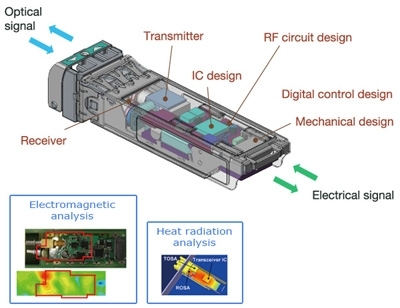- Related articles
- The difference between QSFP+ and CSFP
- Optical Transceivers for Cisco WS-C3750G-24PS-S Switch
- All Cisco CWDM-GBIC-1490's information (List price, Specs, Datasheet PDF, Compatibility ma
- Optical Transceivers for Cisco SF300-24PP-K9-UK Switch
- All Cisco SFP-OC48-LR2's information (List price, Specs, Datasheet PDF, Compatibility matr
- Optical Transceivers for Cisco SRW2048-EU Switch
- What is LX and EX in Transceiver?
- What is 100BASE FX?
- All Cisco DWDM-SFP10G-61.41's information (List price, Specs, Datasheet PDF, Compatibility
- All Cisco DWDM-XENPAK-52.52's information (List price, Specs, Datasheet PDF, Compatibility

Definition:
A transceiver is a device comprising both a transmitter and a receiver which are combined and share common circuitry or a single housing. When no circuitry is common between transmit and receive functions, the device is a transmitter-receiver. The term originated in the early 1920s. Similar devices include transponders, transverters, and repeaters.
| sfp sx transceiver | sfp lx transceiver |
What is transceiver and what does it do?
A transceiver is a combination transmitter/receiver in a single package. The term applies to wireless communications devices such as cellular telephones, cordless telephone sets, handheld two-way radios, and mobile two-way radios. Occasionally the term is used in reference to transmitter/receiver devices in cable or optical fiber systems. In a radio transceiver, the receiver is silenced while transmitting. An electronic switch allows the transmitter and receiver to be connected to the same antenna, and prevents the transmitter output from damaging the receiver. With a transceiver of this kind, it is impossible to receive signals while transmitting. This mode is called half duplex. Transmission and reception often, but not always, are done on the same frequency.
What is transceiver in networking?
The term transceiver does not necessarily describe a separate network device but rather an integrated technology embedded in devices such as network cards. In a network environment, a transceiver gets its name from being both a transmitter and a receiver of signals, such as analog or digital. Technically, on a LAN the transceiver is responsible to place signals onto the network media and also detecting incoming signals traveling through the same cable. Given the description of the function of a transceiver, it makes sense that that technology would be found with network cards. Although transceivers are found in network cards, they can be external devices as well. As far as networking is concerned, transceivers can ship as a module or chip type. Chip transceivers are small and are inserted into a system board or wired directly on a circuit board. Module transceivers are external to the network and are installed and function similarly to other computer peripherals, or they may function as standalone devices.
What is transceiver unit?
In Ethernet networks, a transceiver is also called a Medium Access Unit (MAU). In radio communications, a transceiver is a two-way radio that combines both a radio transmitter and a receiver that exchanges information in half-duplex mode.
Conclusion:
The primary advantage of using a transceiver rather than a separate transmitter and receiver is cost. In a transceiver, many of the components can be shared during both transmit and receive operations. Another advantage is that transceivers can be tuned more easily than separate units. A disadvantage of using a transceiver is that while duplex operation is not possible with most transceivers, communication must sometimes be carried out on two different frequencies. Although this is a receiver’s sensitivity drops to -107 dBm. Since a loss of 3 dB reduces the sensitivity by 1/2, the input signal will have to be twice as large to be detected.
Please click to check more related concepts:
| Transceivers Package | Ethernet standard | Application | Transceivers Wavelength | Fiber mode |
| SFP | 1000Base-X | Bidi | Multi-mode | |
| SFP+ | 100Base-FX | DWDM | ||
| XFP | 1000BASE-T | WDM | ||
| QSFP+ | ||||
| X2 | ||||
| GBIC | ||||
| CFP | ||||
| CSFP |







































































